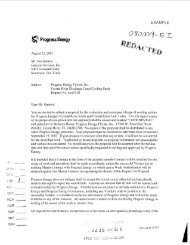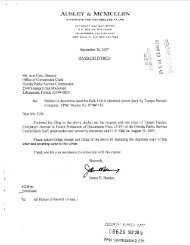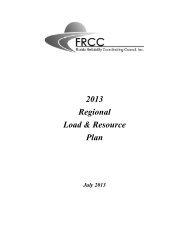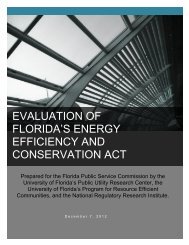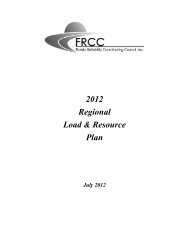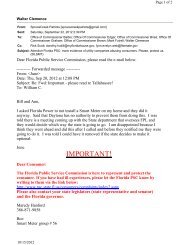Review of 2008 Ten-Year Site Plans - Public Service Commission
Review of 2008 Ten-Year Site Plans - Public Service Commission
Review of 2008 Ten-Year Site Plans - Public Service Commission
You also want an ePaper? Increase the reach of your titles
YUMPU automatically turns print PDFs into web optimized ePapers that Google loves.
3. ENERGY DEMAND<br />
A utility’s load and energy forecasts serve as the starting point for determining the timing and<br />
size <strong>of</strong> new capacity additions needed to reliably serve load. The first step toward building an energy<br />
efficient Florida begins with minimizing the load and energy requirements which the utilities must<br />
meet. Reduced load and energy requirements are essential in reducing the burning <strong>of</strong> fossil fuels and<br />
deferring the need for additional generating capacity. Historical data forms the foundation for utility<br />
load and energy forecasts. These data take into account energy usage patterns, trends in population<br />
growth, demographics, weather data for the utility's service territory, appliance-specific saturation, and<br />
energy consumption characteristics.<br />
Florida’s electrical demand and energy requirements are somewhat unique due to the fact that<br />
the customer base is heavily weighted toward residential customers. As shown in Table 2 below,<br />
residential customers make up nearly 89 percent <strong>of</strong> Florida’s electric customers, and they purchase<br />
more than 50 percent <strong>of</strong> the state’s electric energy. Therefore, residential customers have the greatest<br />
influence over the state’s load and energy forecasts.<br />
Table 2. Characteristics <strong>of</strong> Florida’s Electric Customers (2007 Actual)<br />
Customer Class Number <strong>of</strong> Customers % <strong>of</strong> Customers Energy Sales (GWh) % <strong>of</strong> Sales<br />
Residential 8,318,132 088.6 116,132 052.3<br />
Commercial 1,029,331 011.0 082,758 037.3<br />
Industrial 0,035,733 000.4 023,107 010.4<br />
Total 9,383,196 100.0 221,997 100.0<br />
Load and Energy Forecasts<br />
Utility projections indicate that both the summer and the winter peak demand will increase<br />
approximately 10,000 MW over the planning period. The utilities’ current summer peak demand<br />
forecast, however, is an average <strong>of</strong> nearly 800 MW lower than last year’s forecast for the same years<br />
(<strong>2008</strong>-2016). Similarly, winter peak demand forecasts are an average <strong>of</strong> more than 1,100 MW lower<br />
than last year’s forecasts. Such a trend can be attributed primarily to a decrease in the economy and a<br />
slowing state population growth. Figure 2 on the following page illustrates the decrease in load<br />
projection and the total peak demand projections over the planning period. The effects <strong>of</strong> the<br />
decreased peak demand forecasts with respect to utility generation are discussed in Chapter 4.<br />
<strong>Review</strong> <strong>of</strong> <strong>2008</strong> <strong>Ten</strong>-<strong>Year</strong> <strong>Site</strong> <strong>Plans</strong> - 8 -




